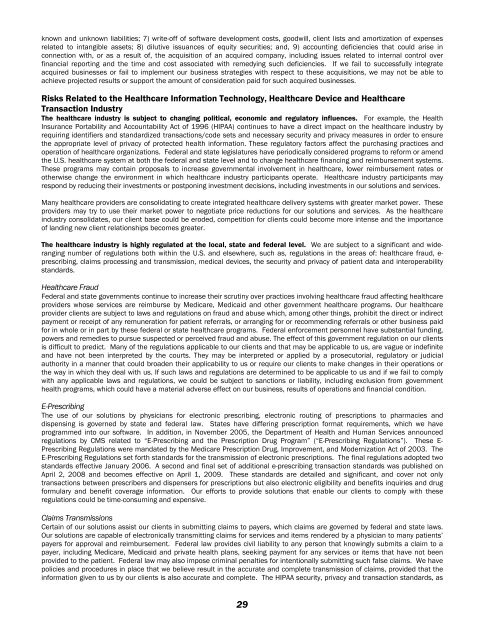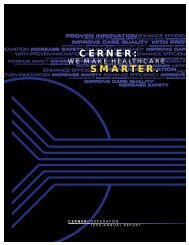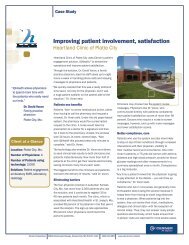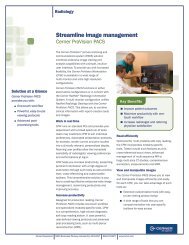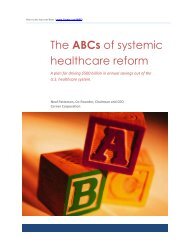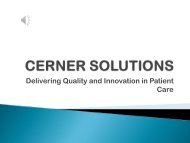The ABCs of systemic healthcare reform - Cerner Corporation
The ABCs of systemic healthcare reform - Cerner Corporation
The ABCs of systemic healthcare reform - Cerner Corporation
- No tags were found...
You also want an ePaper? Increase the reach of your titles
YUMPU automatically turns print PDFs into web optimized ePapers that Google loves.
known and unknown liabilities; 7) write-<strong>of</strong>f <strong>of</strong> s<strong>of</strong>tware development costs, goodwill, client lists and amortization <strong>of</strong> expenses<br />
related to intangible assets; 8) dilutive issuances <strong>of</strong> equity securities; and, 9) accounting deficiencies that could arise in<br />
connection with, or as a result <strong>of</strong>, the acquisition <strong>of</strong> an acquired company, including issues related to internal control over<br />
financial reporting and the time and cost associated with remedying such deficiencies. If we fail to successfully integrate<br />
acquired businesses or fail to implement our business strategies with respect to these acquisitions, we may not be able to<br />
achieve projected results or support the amount <strong>of</strong> consideration paid for such acquired businesses.<br />
Risks Related to the Healthcare Information Technology, Healthcare Device and Healthcare<br />
Transaction Industry<br />
<strong>The</strong> <strong>healthcare</strong> industry is subject to changing political, economic and regulatory influences. For example, the Health<br />
Insurance Portability and Accountability Act <strong>of</strong> 1996 (HIPAA) continues to have a direct impact on the <strong>healthcare</strong> industry by<br />
requiring identifiers and standardized transactions/code sets and necessary security and privacy measures in order to ensure<br />
the appropriate level <strong>of</strong> privacy <strong>of</strong> protected health information. <strong>The</strong>se regulatory factors affect the purchasing practices and<br />
operation <strong>of</strong> <strong>healthcare</strong> organizations. Federal and state legislatures have periodically considered programs to <strong>reform</strong> or amend<br />
the U.S. <strong>healthcare</strong> system at both the federal and state level and to change <strong>healthcare</strong> financing and reimbursement systems.<br />
<strong>The</strong>se programs may contain proposals to increase governmental involvement in <strong>healthcare</strong>, lower reimbursement rates or<br />
otherwise change the environment in which <strong>healthcare</strong> industry participants operate. Healthcare industry participants may<br />
respond by reducing their investments or postponing investment decisions, including investments in our solutions and services.<br />
Many <strong>healthcare</strong> providers are consolidating to create integrated <strong>healthcare</strong> delivery systems with greater market power. <strong>The</strong>se<br />
providers may try to use their market power to negotiate price reductions for our solutions and services. As the <strong>healthcare</strong><br />
industry consolidates, our client base could be eroded, competition for clients could become more intense and the importance<br />
<strong>of</strong> landing new client relationships becomes greater.<br />
<strong>The</strong> <strong>healthcare</strong> industry is highly regulated at the local, state and federal level. We are subject to a significant and wideranging<br />
number <strong>of</strong> regulations both within the U.S. and elsewhere, such as, regulations in the areas <strong>of</strong>: <strong>healthcare</strong> fraud, e-<br />
prescribing, claims processing and transmission, medical devices, the security and privacy <strong>of</strong> patient data and interoperability<br />
standards.<br />
Healthcare Fraud<br />
Federal and state governments continue to increase their scrutiny over practices involving <strong>healthcare</strong> fraud affecting <strong>healthcare</strong><br />
providers whose services are reimburse by Medicare, Medicaid and other government <strong>healthcare</strong> programs. Our <strong>healthcare</strong><br />
provider clients are subject to laws and regulations on fraud and abuse which, among other things, prohibit the direct or indirect<br />
payment or receipt <strong>of</strong> any remuneration for patient referrals, or arranging for or recommending referrals or other business paid<br />
for in whole or in part by these federal or state <strong>healthcare</strong> programs. Federal enforcement personnel have substantial funding,<br />
powers and remedies to pursue suspected or perceived fraud and abuse. <strong>The</strong> effect <strong>of</strong> this government regulation on our clients<br />
is difficult to predict. Many <strong>of</strong> the regulations applicable to our clients and that may be applicable to us, are vague or indefinite<br />
and have not been interpreted by the courts. <strong>The</strong>y may be interpreted or applied by a prosecutorial, regulatory or judicial<br />
authority in a manner that could broaden their applicability to us or require our clients to make changes in their operations or<br />
the way in which they deal with us. If such laws and regulations are determined to be applicable to us and if we fail to comply<br />
with any applicable laws and regulations, we could be subject to sanctions or liability, including exclusion from government<br />
health programs, which could have a material adverse effect on our business, results <strong>of</strong> operations and financial condition.<br />
E-Prescribing<br />
<strong>The</strong> use <strong>of</strong> our solutions by physicians for electronic prescribing, electronic routing <strong>of</strong> prescriptions to pharmacies and<br />
dispensing is governed by state and federal law. States have differing prescription format requirements, which we have<br />
programmed into our s<strong>of</strong>tware. In addition, in November 2005, the Department <strong>of</strong> Health and Human Services announced<br />
regulations by CMS related to “E-Prescribing and the Prescription Drug Program” (“E-Prescribing Regulations”). <strong>The</strong>se E-<br />
Prescribing Regulations were mandated by the Medicare Prescription Drug, Improvement, and Modernization Act <strong>of</strong> 2003. <strong>The</strong><br />
E-Prescribing Regulations set forth standards for the transmission <strong>of</strong> electronic prescriptions. <strong>The</strong> final regulations adopted two<br />
standards effective January 2006. A second and final set <strong>of</strong> additional e-prescribing transaction standards was published on<br />
April 2, 2008 and becomes effective on April 1, 2009. <strong>The</strong>se standards are detailed and significant, and cover not only<br />
transactions between prescribers and dispensers for prescriptions but also electronic eligibility and benefits inquiries and drug<br />
formulary and benefit coverage information. Our efforts to provide solutions that enable our clients to comply with these<br />
regulations could be time-consuming and expensive.<br />
Claims Transmissions<br />
Certain <strong>of</strong> our solutions assist our clients in submitting claims to payers, which claims are governed by federal and state laws.<br />
Our solutions are capable <strong>of</strong> electronically transmitting claims for services and items rendered by a physician to many patients’<br />
payers for approval and reimbursement. Federal law provides civil liability to any person that knowingly submits a claim to a<br />
payer, including Medicare, Medicaid and private health plans, seeking payment for any services or items that have not been<br />
provided to the patient. Federal law may also impose criminal penalties for intentionally submitting such false claims. We have<br />
policies and procedures in place that we believe result in the accurate and complete transmission <strong>of</strong> claims, provided that the<br />
information given to us by our clients is also accurate and complete. <strong>The</strong> HIPAA security, privacy and transaction standards, as<br />
29


